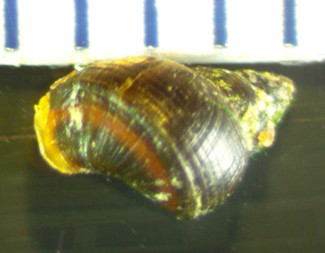Description: As with other members of family Littorinidae, the periostracum is present but not thick and hairy; There is no siphonal notch or canal. The shell height is greater than but not more than twice the diameter, with a clearly visible spire. The inside of the shell is not pearly. It does not have an open umbilicus. Littorina subrotundata has a shell that is higher than wide. The body whorl is fairly globose. The spire has about 4 whorls and tapers to an acute apex. The shell is thinner than that of most Littorina species and the whorls do not have spiral ridges. The aperture is about half the shell height and teardrop shaped. The margin of the columella curls and forms a narrow groove under it. The animal has a horny operculum. Brown with narrow whitish or light brown spiral bands. Maximum height 8 mm (most smaller).
How to Distinguish from Similar Species: Few other littorinas live in the upper saltmarsh. An unnamed Littorina sp has evenly spaced dark brown and yellow bands (bands of a similar width) and a bilaterally symmetrical aperture. It is found more commonly in Coos Bay, Oregon than in Washington waters. I have found Littorina sitkana in rather similar areas (see below), but that species has spiral ridges on the shell.
Geographical Range: Reported from Humboldt Bay, California to southern British Columbia
Depth Range: Very high intertidal
Habitat: In very high intertidal of salt marshes, on or near Salicornia (pickleweed).
Biology/Natural History:
This snail
has been a candidate for listing as an endangered species both by
Washington
State and by the U.S. Fish and Wildlife Service. I didn't
find records
of other people finding it in the Salish Sea (except at Neah Bay).
| Return to: | |||
| Main Page | Alphabetic Index | Systematic Index | Glossary |
References:
Dichotomous Keys:Burke, 2013
Kozloff 1983, 1996 (as Algamorda subrotundata)
General References:
Lamb and Hanby, 2005
Scientific Articles:
Web sites:
General Notes and
Observations: Locations, abundances,
unusual behaviors:

This individual was under the Salicornia
at Penn Cove, along with multiple scattered Littorina
sitkana individuals. The ruler
markings are millimeters.
The narrow yellowish band on a brown background is clearly
visible.
However, there are the beginnings of spiral ridges on the body whorl so
this could just be an immature L.
sitkana.
Authors and Editors of
Page:
Dave Cowles (2014): Created original page
CSS coding for page developed by Jonathan Cowles (2007)
Salish Sea Invertebrates web site provided courtesy of Walla
Walla University
